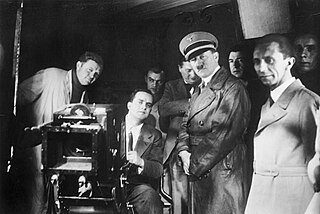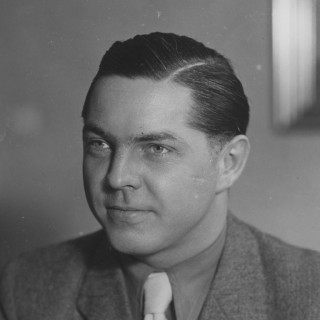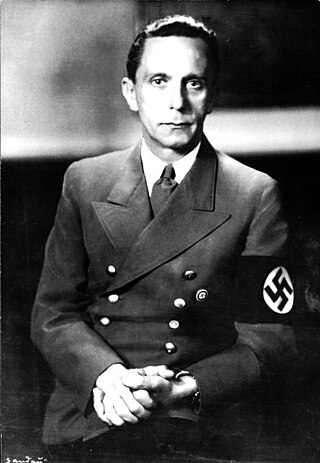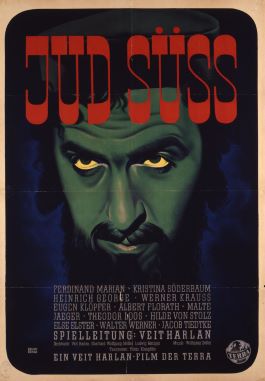
Paul Joseph Goebbels was a German Nazi politician and philologist who was the Gauleiter of Berlin, chief propagandist for the Nazi Party, and then Reich Minister of Propaganda from 1933 to 1945. He was one of Adolf Hitler's closest and most devoted followers, known for his skills in public speaking and his deeply virulent antisemitism which was evident in his publicly voiced views. He advocated progressively harsher discrimination, including the extermination of the Jews in the Holocaust.

Degenerate art was a term adopted in the 1920s by the Nazi Party in Germany to describe modern art. During the dictatorship of Adolf Hitler, German modernist art, including many works of internationally renowned artists, was removed from state-owned museums and banned in Nazi Germany on the grounds that such art was an "insult to German feeling", un-German, Freemasonic, Jewish, or Communist in nature. Those identified as degenerate artists were subjected to sanctions that included being dismissed from teaching positions, being forbidden to exhibit or to sell their art, and in some cases being forbidden to produce art.

The Nazi regime in Germany actively promoted and censored forms of art between 1933 and 1945. Upon becoming dictator in 1933, Adolf Hitler gave his personal artistic preference the force of law to a degree rarely known before. In the case of Germany, the model was to be classical Greek and Roman art, seen by Hitler as an art whose exterior form embodied an inner racial ideal. It was, furthermore, to be comprehensible to the average man. This art was to be both heroic and romantic. The Nazis viewed the culture of the Weimar period with disgust. Their response stemmed partly from conservative aesthetics and partly from their determination to use culture as propaganda.

Nazism made extensive use of the cinema throughout its history. Though it was a relatively new technology, the Nazi Party established a film department soon after it rose to power in Germany. Both Adolf Hitler and his propaganda minister Joseph Goebbels used the many Nazi films to promote the party ideology and show their influence in the burgeoning art form, which was an object of personal fascination for Hitler. The Nazis valued film as a propaganda instrument of enormous power, courting the masses by means of slogans that were aimed directly at the instincts and emotions of the people. The Department of Film also used the economic power of German moviegoers to influence the international film market. This resulted in almost all Hollywood producers censoring films critical of Nazism during the 1930s, as well as showing news shorts produced by the Nazis in American theaters.

The German Resistance Memorial Center is a memorial and museum in Berlin, capital of Germany.

Fritz Hippler was a German filmmaker who ran the film department in the Propaganda Ministry of Nazi Germany, under Joseph Goebbels. He is best known as the director of the propaganda film Der Ewige Jude .
Germany has taken many forms throughout the history of censorship in the country. Various regimes have restricted the press, cinema, literature, and other entertainment venues. In contemporary Germany, the Grundgesetz generally guarantees freedom of press, speech, and opinion.

The Reich Ministry for Public Enlightenment and Propaganda, also known simply as the Ministry of Propaganda, controlled the content of the press, literature, visual arts, film, theater, music and radio in Nazi Germany.

The Nazi book burnings were a campaign conducted by the German Student Union to ceremonially burn books in Nazi Germany and Austria in the 1930s. The books targeted for burning were those viewed as being subversive or as representing ideologies opposed to Nazism. These included books written by Jewish, half-Jewish, communist, socialist, anarchist, liberal, pacifist, and sexologist authors among others. The initial books burned were those of Karl Marx and Karl Kautsky, but came to include very many authors, including Albert Einstein, Helen Keller, writers in French and English, and effectively any book incompatible with Nazi ideology. In a campaign of cultural genocide, books were also burned en masse by the Nazis in occupied territories, such as in Poland.

Jud Süß is a 1940 Nazi German historical drama and propaganda film produced by Terra Film at the behest of Joseph Goebbels. It is considered one of the most antisemitic films of all time. The film was directed by Veit Harlan, who wrote the screenplay with Eberhard Wolfgang Möller and Ludwig Metzger. The leading roles were played by Ferdinand Marian and Harlan's wife Kristina Söderbaum; Werner Krauss and Heinrich George played key supporting roles.

The Reich Chamber of Music was a government agency which operated as a statutory corporation controlled by the Ministry of Public Enlightenment and Propaganda that regulated the music industry in Nazi Germany between 1933 and 1945. It promoted "good German music" which was composed by Aryans and seen as consistent with Nazi ideals, while suppressing other, "degenerate" music, which included atonal music, jazz, and, especially, music by Jewish composers. The Chamber was founded in 1933 by Joseph Goebbels as part of the Reich Chamber of Culture, and it operated until the fall of the Nazi Germany in 1945.
German Exilliteratur is the name for works of German literature written in the German diaspora by refugee authors who fled from Nazi Germany, Nazi Austria, and the occupied territories between 1933 and 1945. These dissident writers, poets and artists, many of whom were of Jewish ancestry or held anti-Nazi beliefs, fled into exile in 1933 after the Nazi Party came to power in Germany and after Nazi Germany annexed Austria by the Anschluss in 1938, abolished the freedom of press, and started to prosecute authors and ban works.

The Reich Chamber of Culture was a government agency in Nazi Germany. It was established by law on 22 September 1933 in the course of the Gleichschaltung process at the instigation of Reich Minister Joseph Goebbels as a professional organization of all German creative artists. Defying the competing ambitions of the German Labour Front (DAF) under Goebbels' rival Robert Ley, it was meant to gain control over the entire cultural life in Germany creating and promoting Aryan art consistent with Nazi ideals.

Negermusik was a derogatory term used by the Nazi Party during the Third Reich to demonize musical styles that had been invented by black people such as blues and jazz. The Nazi Party viewed these musical styles as degenerate works created by an "inferior" race and they were therefore prohibited. The term, at that same time, was also applied to indigenous music styles of black Africans.

Music in Nazi Germany, like all cultural activities in the regime, was controlled and "co-ordinated" (Gleichschaltung) by various entities of the state and the Nazi Party, with Propaganda Minister Joseph Goebbels and the prominent Nazi theorist Alfred Rosenberg playing leading – and competing – roles. The primary concerns of these organizations was to exclude Jewish composers and musicians from publishing and performing music, and to prevent the public exhibition of music considered to be "Jewish", "anti-German", or otherwise "degenerate", while at the same time promoting the work of favored "Germanic" composers, such as Richard Wagner and Anton Bruckner. These works were believed to be positive contributions to the Volksgemeinschaft, or German folk community.

The Degenerate Art exhibition was an art exhibition organized by Adolf Ziegler and the Nazi Party in Munich from 19 July to 30 November 1937. The exhibition presented 650 works of art, confiscated from German museums, and was staged in counterpoint to the concurrent Great German Art Exhibition. The day before the exhibition started, Adolf Hitler delivered a speech declaring "merciless war" on cultural disintegration, attacking "chatterboxes, dilettantes and art swindlers". Degenerate art was defined as works that "insult German feeling, or destroy or confuse natural form or simply reveal an absence of adequate manual and artistic skill". One million people attended the exhibition in its first six weeks. A U.S. critic commented, "There are probably plenty of people—art lovers—in Boston, who will side with Hitler in this particular purge". This particular take is controversial, however, given the greater political context of the exhibition.
Censorship in the Czech Republic had been highly active until 17 November 1989 and the fall of Communism in the former Czechoslovakia. Czech Republic was ranked as the 13th most free country in the World Press Freedom Index in 2014.

Nazi architecture is the architecture promoted by Adolf Hitler and the Nazi regime from 1933 until its fall in 1945, connected with urban planning in Nazi Germany. It is characterized by three forms: a stripped neoclassicism, typified by the designs of Albert Speer; a vernacular style that drew inspiration from traditional rural architecture, especially alpine; and a utilitarian style followed for major infrastructure projects and industrial or military complexes. Nazi ideology took a pluralist attitude to architecture; however, Hitler himself believed that form follows function and wrote against "stupid imitations of the past".

Alfred-Ingemar Berndt was a German Nazi journalist, writer and close collaborator of Reich Minister of Public Enlightenment and Propaganda Joseph Goebbels.
The Reich Music Days took place from 22 to 29 May 1938 in Düsseldorf. They were a Nazi propaganda event under the patronage of Joseph Goebbels. Goebbels had originally planned an annual return of the Reichsmusiktage. These were held again in May 1939, but ceased to exist after the beginning of the Second World War.















